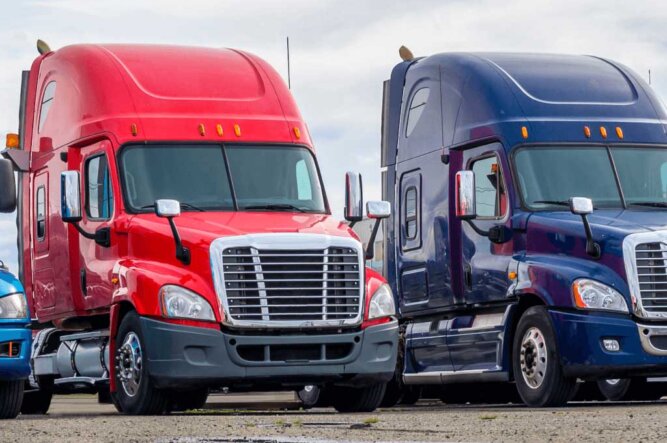Steps to Create a Trucking Business Plan

Join Our
Trusted Network
Grow your business with the load board you can rely on.
In his book Bounce Back: Survive and Thrive in a Business Crisis, author and longtime business broker Richard Mowrey advises: “Never operate your business without a written business plan.” If you have your own trucking business, even as an independent owner-operator, you need a business plan just like any other small business.
A truck driving business plan will serve as your roadmap to the most important thing to any business—profitability. And if you need to approach lenders, investors, or partners to finance your trucking business, it’s the first thing many of them require.
Here’s how to create a trucking business plan.
Importance of a business plan for trucking businesses
More than just a roadmap of how to run your business, business plans show financial institutions, lenders, investors, and potential partners you’re an ideal candidate to do business with. You are essentially selling them on you, your business, and why investing in you and your plan is a sound bet.
In the competitive trucking industry, a business plan can set you up for success. It outlines goals, strategies, and an operational framework. It also provides a better idea of your market, target customers, and competition.
Benefits of a truck driving business plan:
Secures funding
A detailed business plan can help you get loans and attract investors. It shows that you know the industry and have a viable strategy.
Outlining your financial projections and revenue streams also enhances your credibility. With the right plan, you increase your chances of securing capital.
Guides operational decisions
Establishing clear goals allows you to look at your progress and see where you can make changes. For trucking owner-operators, this means knowing your routes, pricing, and customers. A well-defined plan can also help you allocate resources, enhance efficiency, and improve profits.
Attracts potential partners or stakeholders
A business plan can help you attract suppliers and new clients. You can also use it to secure alliances with other trucking companies. By demonstrating your reliability and professionalism, you showcase a commitment to success.
Supports risk management
A business plan will give you a better idea of risks and challenges in the trucking industry. By anticipating these issues, you can find ways to avoid them. This can help you keep your business strong in the face of obstacles.

Helps achieve goals
A business plan is especially vital for trucking owner-operators as it helps you develop goals and a clear path to achieving them. With a forward-thinking approach, you can better adapt to the market in the long run. You can also keep up with technology changes and evolving customer demands.
Improves accountability
With a clear business plan, you can better measure success. You’ll determine key performance indicators (KPIs) and find ways to achieve them. This accountability can encourage continuous improvement. It also ensures all team members are aligned with the company’s objectives.
Informs marketing strategies
A well-crafted business plan includes a marketing strategy for reaching your target audience. You’ll learn the right marketing channels and tactics to stand out in a competitive market, positioning your business for success.
Steps to take before writing a business plan for your trucking company
Believe it or not, your new trucking company should be an official business before you start writing a business plan. Start here:
- Register your business: Register your trucking company as a business with your business name. There are several ways to register your company, including a sole proprietorship with a DBA, an LLC, a C Corp, or an S Corp. You can register in your state or another one. If you’re unsure which to choose, look to the Small Business Administration’s (SBA) online guides. Many local chapters also offer free advice.
- Get an EIN: Get an employer identification number (EIN) from the IRS with your business name.
- Get a DOT number: Get a federal Department of Transportation (DOT) number. You’ll need to state where you will operate, the number of trucks you will run, and what materials you will be hauling.
- Apply for your MC number: Apply for a motor carrier (MC) number on the fmcsa website.
- File a BOC-3: File a BOC-3 with the Federal Motor Carrier Safety Administration (FMCSA) to give you a presence in the states where you will operate.
- Get truck insurance: When choosing truck insurance, talk to an agent about recommendations and requirements in your state and the states where you will be operating.
- Get your plates: Get your apportioned plates and set up an International Registration Plan (IRP). This will help you domestically, too, if your lane includes California.
- Set up an IFTA: Set up an International Fuel Tax Agreement (IFTA) to normalize fuel taxes in every state and Canadian province.
- Get a UCR: Get a Unified Carrier Registration (UCR) by visiting UCR.gov.
This seems like a lot of steps, and it is. But it’s important to know what each step means. For example, the UCR is how you pay fees to supplement motor carrier registration, education, and safety. Be aware that annual and/or ongoing costs may be associated with each step.
Information you need to create your trucking business plan
Once you’ve registered, it’s time to research even more deeply so you’re fully equipped to write a business plan. Educate yourself on industry basics and general business knowledge like cash flow, profit and loss (P&L), return on investment (ROI), and other standard terms. If you haven’t already, also consider the following:
- Assets: Figure out what assets you have and what they are worth. Your truck may be an asset if it’s paid off. Otherwise, it might be a liability. Understand the difference between those terms.
- Costs of business: What will it cost to operate your business? Tally up your projected average fuel cost, miles per gallon, and miles driven. Operation and maintenance costs help you figure out where to set your rates to be profitable.
- Cost management: Learn how to manage costs, project revenue (the money you will make), and expenses to determine your profit margin.
- Rates: Know the going rates in different freight lanes. Also, understand spot market versus contract market rates. Decide if you will add fuel surcharges to your rates, balancing the pros and cons.
- Freight types: Set up your operating procedures for different freight types and where they’ll be picked up and dropped off. These are the “logistics of the logistics business.”
These steps are especially necessary if you will be seeking financing. Lenders will want to know how you plan to make money, as well as your backup plan if things get bumpy.
How to write a truck driving business plan—key components
If you’re going to include yourself in your business plan, you also need to set your strategy apart from others. Tailor it to showcase who you and your company are, what you’re doing, and how it’s different. Keep the above section in mind, but also know that it’s somewhat of a formula. Investors expect to see specific elements in a particular format and order.
The business plan you create is for investors and financial backers, but also for you. Set it up in a way you understand and can refer to often. Here are the essential parts.
1. Executive summary
This is a brief description of your company but also yourself. Why are you starting a trucking company? Showcase who you are and what sets you apart. This is your chance to make a great first impression. Consider hiring a professional writer or editor to help with your executive summary and give your plan a final polish once you’ve got the basics down. For best results, write this section last.
2. Company description
This is the “About Us” section. Here, you can go into more detail about who you are and your business experience and knowledge. Finally, reiterate what sets you apart from your competition. Sample details:
- Will you specialize in a specific freight area?
- Will you specialize in a particular region, cargo type, or logistics arm?
- Do you have a unique partnership opportunity with connections?
- Who will be working with you? Will you have other managers?
- Who will your employees be? What characteristics will make them valuable to your team?
Use this section to describe your ideal client. Explain how you plan to connect to them and build a client base. This is the meat and potatoes of what your business does.
3. Operational plan
If the company description is the “who” behind your business, the operational plan is the “how” and the “what.” What are the critical roles in your company? How will you handle routing and dispatch? Will you be both operating a route and running the business? Will there be other drivers?
Secondly, describe how you will use technology to keep your business profitable. For example:
- Load boards: You can use load boards to find reliable brokers and money-making loads quickly and plan optimal routes for maximum profitability.
- Freight factoring: Freight factoring helps you get paid quicklyrather than waiting for the load broker to pay. You can even apply for advances and get broker credit checks right away.
- Business software: Show that you plan to use other small business software for accounting, mileage tracking, and more. Automating your accounting process will save you both time and money.
Trucking has become a high-tech industry. It’s essential to show how you will take advantage of advanced routing and other tactics to make your business as profitable as possible. Using technology will help set your trucking company apart from your competition.
4. Risk plan
Your business plan should show that you know things go wrong in business and that you have a plan for them. It should demonstrate that you understand how to keep your business running, build a client base, and track expenses, profit, loss, and cash flow. It should also show that you’re financially savvy overall, with knowledge of taxes and corporate structure.
5. Services
Here, include the details of the services you provide to your customers. There are two vital things in this section:
- The customer perspective: What problem does your customer have that you are solving? Maybe you’re making gas truck runs to specific areas in Idaho because they don’t have a fuel pipeline system or local refineries. Explain how that is profitable. This shows why your services are in demand.
- Breakdown of logic: Breaking down your logic shows that you understand the market and profitability. Include pricing, materials you haul, and other details. If you include detailed pricing, explain why you set it that way.

6. Market analysis
The trucking market is crowded. What need do you meet, and how well do you understand it? This is what you explain here. Talk about your target market, how large or small it is, who your competition is, and what your customers need that you will provide. Demonstrating a thorough understanding of your competition illustrates your ability to compete. Include the following components:
- Competitor analysis: This section is all about your competitors. Who are they? Who are their customers? What are their strengths and weaknesses? How will you fill a gap that they currently aren’t targeting as well as possible?
- Pricing and margins: What is your pricing structure? How do your prices compare to those of your competition? What margins do you need to turn a profit?
- Industry regulations: Federal and state laws can sink a trucking company if you don’t fully understand them and develop a compliance plan. Detail regulations such as hours of service limits, fuel emissions requirements, and the various permits and licenses you will need. Then, explain how you will ensure that your company complies.
You’ll also need to know how much of the market you can expect to gain and how you plan to get there. Include profit and loss projections and how you came to those conclusions. Finally, show that you understand government regulations and how they affect your business.
7. Industry knowledge
Detail any expertise you have in the trucking industry and any area you plan to specialize in. Your investors will want to know that you are more than a driver.
Demonstrate that you have what it takes to start a trucking business. You are not only a truck driver. You are a professional, capable of running a successful trucking company. You understand what it will take to operate a business, be profitable in the trucking industry, and achieve business success. Make sure you outline how you will stand out from your competition. Avoid buzzwords like friendlier, faster, on-time, and reliable. Everyone uses those.
Simon Sinek probably says it best: “People buy from you because of why you do what you do, not because of what you do.” You likely got into trucking for a reason. Maybe there’s a passion beyond just making money. That “why” and the reason you want to run a trucking business needs to come through in everything you do and say. That will set you apart and hopefully get investors and other financial backers excited.
8. Management and personnel
Your business plan should cover your approach to hiring people if you plan to have staff or additional office help. Explain your hiring process and how you will onboard new employees. Owner-operators and carriers will have to follow the compliance standards of the shippers and brokers they work with.
Make sure you get ahead of this and understand basic industry standards, safety records, and regulatory compliance before taking on additional carriers. If you hire a carrier who doesn’t comply with industry standards or has a less-than-stellar safety record, you could put your entire business at risk.
Hiring good, qualified drivers with solid performance records will go a long way toward helping you grow your business and expand your operation to additional freight lanes. You should also have a plan for retaining them since the market is highly competitive and good drivers are in high demand.
If managing people and doing paperwork are not your strong suits, consider hiring management or other personnel to help you run your business. Discuss how you plan to add people in management roles as your needs grow.
9. Sales and marketing strategies
In a crowded market, getting noticed is the number one issue. Explain your marketing strategies. Detail how you will reach new customers and build a loyal base.
At the same time, you must explain how you will handle sales and land new customers. You can use brokers, or you could hire sales personnel to call potential customers for you. Whatever your method, you need to have a sales strategy and outline it here.
10. Financial projections
How far out do you need to predict your finances? The general rule is five years. You can always adjust your plan as the industry changes, but you need to show your investors that you have a plan. This also gives you a roadmap to follow. Evaluate future opportunities based on your business plan.
Let’s say you want to purchase a new truck to serve a new territory, but it’s a type of truck and cargo you didn’t have in your business plan. Do you have enough of that specific experience to meet those needs realistically? Is this an opportunity or a distraction? How will it affect your finances, both short- and long-term?
11. Funding request
Not all business plans include this section. But if you need money, investors or partners will want to see how much you need. Calculate this by subtracting the money you currently have from your total projected costs. List your assets and what you’re contributing to jump-start the business. Investors like to see that you have a stake before investing their money in your venture. You can include a cash flow statement and a profit-and-loss statement to help present your situation.
Putting it all together
Finalize your business plan with these final tips:
- Organize all information: Write clearly and consistently so your business plan is easy to follow.
- Turn to professionals: If you need help writing your business plan, the SBA and other small business groups offer some great free resources to get you started. You can also look for templates that help arrange your information in a polished way.
- Review and edit: Look over your business plan before presenting it to stakeholders and edit for accuracy.
- Implement and monitor: Implement your business plan and make adjustments as needed to ensure success.

Jump-start your trucking business with Truckstop
A trucking business plan is just like any other small company business plan. You need to know your industry, show that you understand it, and provide a solid financial plan for running a profitable business. But a trucking business plan is not only for investors. It’s also a roadmap from now to where you’ll be in five years and beyond.
When you’re ready, we’re here to be your trucking business partner. Established in 1995, Truckstop created the first digital load board to help carriers find loads to move. Today, Truckstop is one of the largest and most trusted brands in the freight transportation industry, connecting tens of thousands of carriers and brokers with technology solutions to manage the entire freight lifecycle.
Truckstop solutions include freight matching, marketplace rates, partner screening and monitoring tools, freight tracking and visibility, transportation management systems (TMS), integrations with most major industry software partners, and complete payment solutions. We are constantly evolving to help you manage every step of the freight lifecycle. To get started, request a demo today!
Get helpful content delivered to your inbox.
Sign up today.
Find high-quality loads fast, get higher rates on every haul, and access tools that make your job easier at every turn.






